Chapter Nine
End of January to mid-March in the Northern Hemisphere
End of July to mid-September in the Southern Hemisphere
The light is expanding, and the earth is awakening, bringing transformation, regeneration, and renewal. Use the solar energy of the season to fire up your intention to initiate change. Let go of the old to make room for the new. This is a time of new beginnings.
Shaking Off Winter and Waking Up to Spring
The new growth cycle has begun, and although we haven’t quite shaken off winter, there are signs that spring is on the way. The first lambs are gamboling in the field, the sun is shining on frostbitten grass, and green shoots are peeping up through the snow.
Between now and the summer solstice in June (December in the Southern Hemisphere), the light will be expanding. The sun is in its waxing phase, and this means that the direction of energy is moving from moon to sun, dark to light, water to fire, yin to yang, inner to outer, and from contemplation to action. Whatever seeds are planted now will expand and grow.
Over the coming weeks the year will rev up, and we too prepare to rev up our own energy so that we can make the most of this expansive, fertile growing season energy. Gradually, we make a shift from inward reflection toward taking outward action. We also consider how we’ll stay connected to our inner wisdom while acting in the world. The world is waking up after her winter sleep; new green shoots appear, flowers open, and blossom buds are forming on trees. In our own life we notice green shoots too, and we ask, what do we wish to blossom in our life over the coming months?
In theory, at this time we should be poised like an athlete at the starting line of a race, ready to leap into action. However, at the end of winter many of us are still in hibernation mode. Fortunately, our yoga practice can energize and help us shake off winter lethargy. We can take our lead from Nature; slowly she begins to paint jewellike splashes of color, life, and light into the monochrome winter landscapes. We too can make a slow transition, from the inward, contemplative focus of winter to the outward, active focus of spring.
The irrepressible creativity of nature is stirring as spring approaches. What is waking up inside of you at this time and wishing to be expressed? What is new within you and waiting to be brought out into the light? The waxing sun ignites a spark of passion within us and our ideas bloom like flowers.
Many studies show that creativity is good for your health and a great way of relaxing.25 Your yoga and meditation practice can enhance your creativity by unlocking the treasure trove of your subconscious mind. Now is the time to get out that mindful coloring book and crayons that have been gathering dust on a high shelf, pick up that half-knitted jumper, bake an exquisite cake, make your body into a love song, dance a dance, paint a room, write a poem, design a yoga practice—just do whatever it takes to get your creative juices flowing.
We are at the tail end of winter, and soon the longer, warmer days will be with us again. Now is the time to talk with your loved ones about the things you want to do together this spring and summer. Have fun and make a love-to-do list; let your imagination run wild and come up with a list of fun activities for the coming months. And remember: magic happens!
During the growing season, whatever is planted will expand and grow, so now is the time to plant seeds of love. Relationships are like plants: they need to be nurtured and fed if they are to grow strong and flourish. Love is a garden, and if you take the time to feed and water your relationships, then love will blossom and grow.
Getting Your Year into Gear!
Spring is a time of new beginnings. Now is a good time to review all aspects of your life and consider what changes you want to make. Research shows that we are more likely to make changes in our life if we talk beforehand about the changes we wish to make.26 So, whether you want to go the gym more often, take up yoga, quit smoking, or eat more healthily, you have more chance of succeeding if you talk to friends, family, and colleagues about what you want to achieve first. This is called change talk. Change talk is when you acknowledge that there are obstacles that stand between you and your goal, and you talk to others about how you will overcome those obstacles. Change talk is motivating, and it means you gather around yourself a band of people to cheer you on to a healthier, happier lifestyle.
As the sun gets stronger, now is the time to fire up your dreams! If you are ambivalent about swinging into action, that’s natural. Just remember to pace yourself. A good way to make the transition from contemplation to action is to allow your action to be guided by your inner wisdom. Your yoga practice can help you to stay centered and grounded, enabling you not to get swept away by the speed, activity, and rush of the coming growing season energy.
What should we do if our dreams have stalled? Sometimes when we feel stuck, it helps to take baby steps, in order to start moving forward again. Or, if you’re staring at a blank page not knowing what to write, just jot down a few words: make a start and more ideas will follow. Baby steps get you moving, get your energy flowing, and prevent stagnation. Take another look at what you want to achieve this growing season, and then break this down into smaller, manageable steps. Which of these is the smallest, easiest step you could take? Resolve to take that step! Now you’re moving forward again.
The ritual of spring cleaning is a gentle way of transitioning from an inward focus to taking action. Completing a mundane job such as tidying your desk or cleaning out a cupboard can shift stuck energy, lift your mood, and boost your confidence. Spring cleaning brushes away the cobwebs and stagnant energy that has collected over winter. If done mindfully, cleaning can be a meditation. (Remember to get your housemates to share in the joy of this housework meditation so that it doesn’t end up becoming a chore.)
If you’re feeling run-down at the end of winter, you might feel the need to give yourself a good spring clean and detox. This makes it a good time to look at the yogic approach to purity (sauca), which is one of the observances, or the personal disciplines, that make up the second of Patanjali’s eight limbs of yoga.
Yoga practice does undeniably have a beneficial purifying and cleansing effect on our system. Yoga postures, breathing practices, meditation, and relaxation all help us let go and detoxify, on both a mental and physical level. However, it’s important to make sure that self-discipline doesn’t turn into an unhealthy self-denial of enjoyment of all the good things in life. Moderation in all things, including moderation!
In the world today, there is money to be made from making people (women in particular) feel “impure” and bad about themselves. Our yoga practice can provide a great antidote to this, as it teaches us to focus on how we feel on the inside, rather than obsessing about our outward appearance. Which yoga techniques have you found help you to access a sense of being okay as you are? What else has helped you feel comfortable in your own skin and good about yourself?
If we do find ourselves striving to create a bubble of purity, it’s worth widening the lens and shifting our focus from our own individual purification to working to create a world that is pure and unpolluted for everyone to enjoy. What small steps could you take to make this dream a reality? The intense beauty of the earth in spring reminds us of the need to take care of this precious planet that we call home.
Growing Your Own Home Yoga Practice
Early spring is a great time to get creative with your yoga practice. Seeds planted now will expand and grow, so why not spend some time and energy planting out seeds for a dazzling yoga garden?
There are many advantages to having a home yoga practice:
• It’s quality time for you. It’s tailored to meet your needs; you can strengthen and tone or relax and unwind.
• It is a healing space where you can nurture and nourish yourself.
• It frees up your creativity and leaves you feeling inspired.
• It’s free—no expensive gym membership.
• It’s enjoyable, and portable too. Wherever you go, your yoga goes with you! With all these benefits, why wouldn’t you practice yoga at home?
At the end of winter your home yoga practice might need some freshening up. Or perhaps you want to practice yoga at home but don’t yet have the confidence. Or your home practice has lapsed, and you want to start it up again. Or maybe you are a yoga teacher suffering from burn-out. Whatever your reasons, here are some questions that will help you kick-start your home yoga practice:
• What would the benefits of doing a regular home yoga practice be?
• What are the obstacles that stand in the way of practicing yoga at home?
• How will I overcome these obstacles? Which one would be the easiest to tackle?
• If everything went well and I managed to establish a regular home yoga practice, what would it look like? What would I be doing? How would I be feeling? How would my life be different from how it is now?
I have always had a yoga home practice. This is partly due to circumstances, as when I started yoga in my early teens, I wasn’t old enough to go to classes. While waiting for my sixteenth birthday to arrive so I could enroll in a class, I taught myself from books and magazines at home. During this time, yoga became such a personal thing to me that when I did eventually get to my first yoga class, it felt odd to be practicing yoga with other people, a bit like finding yourself naked in a public place! My favorite experience of yoga is still doing it myself at home, and my best teachers are books.
What I try to convey and channel through my teaching is the sense of peace and joy that I derive from my own yoga practice. My intention when I teach is to create an atmosphere where my students can blossom and unfold. I want them to access a peaceful, nourishing, nurturing space within, just as I do myself in my own practice. My home yoga practice is like a deep well that I can draw on to nourish myself and to fuel my teaching.
Initially, it might feel scary to step onto your yoga mat, with just your thoughts, feelings, and bodily sensations for company. It takes courage to come face to face with your true self in yoga. In my younger days I had debilitating anxiety, and being confronted with anxious thoughts during my yoga practice often felt overwhelming. However, over the years I have learnt that if you can stay present to uncomfortable thoughts and feelings as they arise, you uncover within yourself a peaceful place that can lovingly hold and contain them. If you persevere, you will discover within this “aloneness” a sense of freedom, connection, and healing.
A good way to start a home practice is to commit to a daily practice of five to ten minutes a day. Once you are in this habit, you’ll find that you feel so good from doing it that you want to do more. A little forward planning goes a long way; spend some time working out what your practice will be before you step onto your mat. Or, if you feel confident enough, step onto your mat and see where your inner wisdom leads you!
A good way of building confidence and getting used to spending time on your own doing yoga might be to start off using a yoga DVD or YouTube video. To create a calming ambience, light a candle or put on some relaxing music on. All these small steps are ways of planting the seeds of an established yoga practice, and before you know it, your yoga garden will be in full bloom!
Winter to Spring Yoga Practice
As winter turns to spring the world is waking up and coming back to life again. This yoga practice is inspired by the first spring flowers opening into blossom, heralding the arrival of spring.
The practice incorporates a theme of opening and closing to encapsulate that end-of-winter feeling and coming out of hibernation. The yoga flow from Child’s Pose to Upward-Facing Dog reflects this sense of waking up to spring after a long winter sleep.
The practice is energizing and revitalizing. It will help you shake off winter lethargy, boost your mood, and banish winter blues. It opens you up to new possibilities.
It can also be used at any other time of the year. Allow 15 to 20 minutes
1. Blossoming Hands
Close your eyes and draw your awareness inward (or if you prefer, keep your eyes open). Begin to gently open and close your fingers. Make a gentle fist, like a flower closing back to bud. Then spread the fingers like a flower opening. Continue to slowly and gently repeat this opening and closing movement.
Once you have established a rhythm to the movement, bring your awareness to the natural flow of your breath. As you observe the breath, notice how it corresponds to the opening and closing movement of the hands. More detailed instructions for this exercise can be found after this yoga practice.
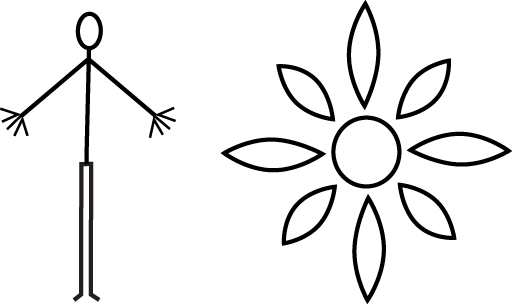
Blossoming Hands
2. Flower Arms
Stand tall, feet hip width apart. In your mind’s eye picture your favorite spring flower. Now place fingertips on shoulders, elbows out to the side; relax shoulders down away from ears. Inhale and open arms out to the side, like a flower opening. Exhale and bend arms, bringing fingertips back to shoulders, like a flower closing back to bud. Repeat 6 times.
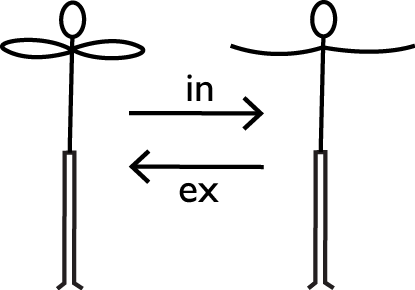
Flower Arms
3. Albatross Sequence 2
Stand tall, feet hip width apart, hands resting on your belly. Inhale and raise arms. Exhale and sweep the arms out to the sides like a bird’s wings as you bend halfway forward, back slightly arched, into Albatross Pose. Stay here and inhale. Exhale and lower into Standing Forward Bend (Uttanasana). Inhale, bending the knees and arching the back. Exhale back down into Forward Bend. Inhale and sweep arms out to the side and up above the head as you come back up to standing. Exhale and lower the hands back to belly. Repeat the sequence 4 times. (See Summer to Autumn Yoga Practice for Albatross Sequence 1.)
For a shorter practice, finish here.

Albatross Sequence 2
4. Warrior 2 Pose (Virabhadrasana 2)
Take the legs wide apart; left foot turns slightly in and right foot turns out. Bend the right knee. Take the arms out at shoulder height, palms facing down. Turn your head to look along your right arm. Stay here for a few breaths. Repeat on the other side.
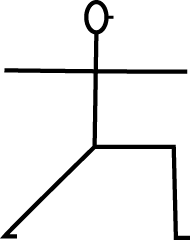
Warrior 2 Pose
5. Wide-Leg Standing Forward Bend Pose (Prasarita Padottanasana)
Take the legs wide apart, feet parallel. Raise the arms out to the sides, just below shoulder height. Inhale and hinge forward from the hip joints into a wide-leg forward bend. Bring the hands to the floor (or for a gentler option, bring the hands to rest on the legs or on raised blocks). Stay here for a few breaths. Return to the starting position.
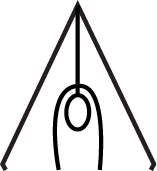
Wide-Leg Standing Forward Bend Pose
6. Lunge Pose (Anjaneyasana) into Hamstring Stretch
Come to tall kneeling. Take your right foot forward; bend the right knee over the ankle. Take your hands to the heart in the Prayer Position (Namaste). For a gentler option, keep the hands here or raise the arms above the head. Stay here for a few breaths. Then come into Hamstring Stretch by straightening the front, right leg, leaning the torso forward over the leg, and resting your fingertips on the floor on either side of the front leg. Stay for a few breaths and then repeat on the other side.

Lunge Pose into Hamstring Stretch
7. Downward-Facing Dog Pose (Adho Mukha Svanasana)
Come onto all fours; turn the toes under and push up into Downward Facing Dog Pose (Adho Mukha Svanasana). Stay here for a few breaths.
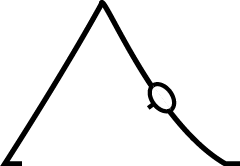
Downward-Facing Dog Pose
8. Child’s Pose (Balasana) into
Upward-Facing Dog (Urdhva Mukha Svanasana)
From Downward-Facing Dog bend the knees and sit back into Child’s Pose (Balasana), arms outstretched along the floor. From Child’s Pose inhale and move forward into Upward-Facing Dog (Urdhva Mukha Svanasana), arching your back and keeping your knees on the floor. Exhale back into Child’s Pose. Repeat 6 times.

Child’s Pose into Upward-Facing Dog
9. Bridge Pose (Setu Bandhasana) into Knees-to-Chest Pose (Apanasana)
Lie on your back, knees bent, feet on the floor hip width apart, arms by your sides. Inhale and peel your back from the floor, taking your arms overhead onto the floor behind you, coming into Bridge Pose. Exhale and lower the back, returning the arms to the sides. Still exhaling (or take an extra breath), curl up into a ball; bring the knees to the chest and the hands to the knees, into Knees-to-Chest Pose. Inhale and come back to the starting position. Stay for one breath and then repeat the sequence. Repeat 4 to 6 times.

Bridge Pose into Knees-to-Chest Pose
10. Knees-to-Chest Pose (Apanasana) into Wide-Leg Stretch
Bring the knees into the chest; rest the fingertips lightly on the knees. Inhale and take the arms overhead and straighten the legs up vertically, heels toward the ceiling. Exhale and take the legs out into a wide V shape. Inhale and bring the legs together again. Exhale and bend the knees into the chest, bringing the fingertips back to the knees. Repeat sequence 4 to 6 times.

Knees-to-Chest Pose into Wide-Leg Stretch
11. Blossoming Hands
Rest for a few breaths here, with knees bent and feet on the floor. Close your eyes and draw your awareness inward (or if you prefer, keep your eyes open). Begin to gently open and close your fingers. Make a gentle fist, like a flower closing back to bud. Then spread the fingers, like a flower opening. Continue to slowly and gently repeat this opening and closing movement.
Once you have established a rhythm to the movement, bring your awareness to the natural flow of your breath. As you observe the breath, notice how it corresponds to the opening and closing movement of the hands. More detailed instructions for this exercise can be found on page 161.
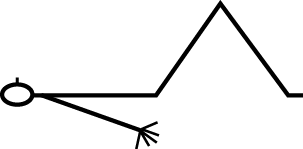
Blossoming Hands
Winter to Spring Yoga Practice Overview
1. Blossoming Hands. Gently open and close fingers. Make a gentle fist, like a flower closing back to bud. Then spread fingers, like a flower opening. Notice how the breath corresponds to opening and closing movement of hands.
2. Flower Arms. Stand tall, feet hip width apart. Picture your favorite spring flower. Inhale: open arms out to the side, like a flower opening. Exhale: bend arms, bringing finger tips back to shoulders, like a flower closing back to bud. Repeat × 6.
3. Albatross Sequence 2. Repeat × 4.
4. Warrior 2. Stay for a few breaths. Repeat on other side.
5. Wide-Leg Standing Forward Bend. Stay for a few breaths.
6. Lunge Pose into Hamstring Stretch. Stay for a few breaths. Repeat on other side.
7. Downward-Facing Dog. Stay for a few breaths.
8. Child’s Pose into Upward-Facing Dog. Repeat × 6.
9. Bridge Pose into Knees-to-Chest Pose. Inhale: into Bridge Pose. Exhale: lower the back, returning arms to sides. Still exhaling (or take extra breath) curl up into Knees-to-Chest Pose. Inhale back to the starting position. Stay for one breath. Repeat × 4–6.
10. Knees-to-Chest into Wide-Leg Stretch. Repeat × 4–6.
11. Blossoming Hands. Gently open and close fingers. Make a gentle fist, like a flower closing back to bud. Then spread fingers, like a flower opening. Notice how the breath corresponds to opening and closing movement of hands.

The Blossoming Hands exercise frees up the breathing, establishing a healthy, relaxed breathing pattern. It also helps maintain suppleness and flexibility of the hands. It has a subtle opening effect on the body’s posture and helps gently energize and lift the mood.
It’s a great way to start a yoga practice. The practice could then be themed around the idea of opening and closing. It can also be used anytime as a stand-alone practice.
Find yourself a comfortable position, either standing, sitting, or lying down. If you are standing, stand with your arms by your side and palms facing forward. If you are sitting, sit with your palms facing up and resting on your thighs. If you are lying down, have both knees bent, feet on the floor and about hip width apart. Arms are by your sides with the palms facing up.
Close your eyes and draw your awareness inward (or if you prefer, keep the eyes open). Begin to gently open and close your fingers. Make a gentle fist, like a flower closing back to bud. Then spread the fingers, like a flower opening. Continue to slowly and gently repeat this opening and closing movement. Once you have established a rhythm to the movement, bring your awareness to the flow of your breath. Breathe naturally; do not try to control the breath.
As you observe the breath, notice in what way the breath corresponds to the opening and closing movement of the hands. Notice when you are breathing in or out in relation to the movement. Simply observe what’s happening as you breathe and move. There’s no right or wrong way to do it.
When you feel ready, gradually allow the movement to subside and come to rest. Continue to observe the flow of your breath and notice what effect the blossoming hands exercise has had upon you.
Tree Wisdom in Winter to Spring
When you are out and about, be on the lookout for signs of fresh growth and new life appearing on trees, such as blossom or leaf buds. Also see if you can notice signs of life around the tree, such as spring flowers, birds, or small animals. Use all your senses to mindfully enjoy these signs that nature is coming back to life again.
Exercise
Trees and Creativity
during Winter to Spring
You can use the time that you have spent mindfully with trees as a springboard for your creativity. If you are stuck for ideas, here are a few ideas to get you started:
• Take some photos on the theme of signs of the arrival of spring. Use them as screen savers. Or print them out and pin them up in places where they will inspire and uplift you. Or share them on social media to cheer and inspire others.
• If you have a favorite type of tree, find out any myths and stories associated with it. Or make up your own myth!
• If you feel an affinity with a particular tree, spend a few moments imagining what this tree would say if it could talk. If you wish, use this tree monologue to inspire your creativity, in whatever medium that appeals to you.
• Grow something! Even if you don’t have a garden, you can grow things indoors, such as cress on cotton wool or a potted avocado stone. Or find out if you can join in with tree planting in your area.
• Try out this chapter’s Winter to Spring Yoga Practice, inspired by a blossom opening in spring.
Meditation upon a Rowan Tree in Winter to Spring
In the center of my garden grows a rowan tree, encircled by a hexagonal wooden table, built for us by a carpenter friend. Every year during the winter the tree is laden down with orange berries, which the birds love to feast upon. According to myth, the rowan tree offers protection when it is planted near the house. Rowan is considered to be a magical tree because on each berry there is to be found a star-shaped pentacle, which is a magical symbol. The rowan tree is known as a flying tree because it sometimes grows almost horizontally from the sides of mountains, and its leaves look like eagles’ wings.
The rowan tree has taught me how to create an extraordinary, magical gift out of ordinary, everyday ingredients—and to keep on giving that gift the whole year round. It was mindfully spending time around rowan trees that inspired this tree prose poem:
I am the Rowan Tree, rainbow tree of immortality, ambrosia to the gods. Slender gray bough; leaves green, pink, gold, and branches reaching up to the heavens. My roots in the soil, wrapping around rocks; my eagle wings take flight and alight where mountainside meets sky. Magical tree, a five-pointed star on each scarlet berry; I offer you protection when I grow near your home. Five petals, five sepals, my creamy-white blossom is the milk of human kindness. I am your mother, daughter, sister, and friend. Creativity, my wood is the spinning wheel that spins the thread of life. Generosity, the lifeblood of fertility, fire in the belly; the first woman was born from a rowan tree.
Winter to Spring Meditation Questions
These questions are designed to be used any time from around the end of January to mid-February in the Northern Hemisphere and from around the end of July to mid-August in the Southern Hemisphere. Guidance on how to use the seasonal meditation questions can be found in Chapter One.
• Nature is coming back to life after her winter sleep. What signs have I noticed of green shoots in my life?
• This is the start of the growing season; whatever is set in motion now will expand and grow. What do I wish to grow more of in my life?
• Which projects do I wish to prioritize, in order that they might have the best chance of coming to fruition over the next few months?
• What actions will I need to take to ensure a successful outcome?
• How can I connect and collaborate with others to ensure the success of each venture?
• What will my spiritual focus for the year be?
• Which values will guide my actions over the coming months?
• How will I stay in touch with my inner wisdom while taking outward action?
• What do I wish to grow in my relationships? What are the seeds of love that I will be planting out?
• What loving actions could I take to ensure my relationships grow healthy and strong?
• Traditionally, this is a time for spring cleaning. Are there any areas of my life that would benefit from a good spring clean?
• Does my work or home environment need a good clean to clear out stagnant energy?
• What physical clutter can I let go of?
• Are there any steps I can take, big or small, to make the earth’s environment cleaner and healthier?
• In spring Nature is at her most creative. How can I draw inspiration from the natural world and allow my own creativity to blossom?
• Can I channel some of this spring-inspired creativity into designing imaginative and nourishing yoga practices for myself?
• Are there any blocks to my creative expression? How will I go about removing them?
• Between now and the summer solstice the days will get longer and the sun stronger. Where is the fiery passion in my life?
• Which activities will nurture and nourish me?
• Which activities are depleting or unhelpful and how do I reduce these?
• How can I have fun? What do I enjoy doing? What am I passionate about? What lights my fire? What makes me happy?
• Are there any seeds of positivity that I could plant to help the various communities that I am a part of to grow healthy and strong?
• As new life unfolds and the first signs of spring appear, what are my plans for getting out and about to enjoy the beauty of the season?
25. Cathy Malchiodi, “Creativity as a Wellness Practice,” Psychology Today, December 31, 2015, https://www.psychologytoday.com/blog/arts-and-health/201512/creativity-wellness-practice.
26. Hal Arkowitz, Henny A. Westra, William R. Miller, and Stephen Rollnick, eds., Motivational Interviewing in the Treatment of Psychological Problems (New York: The Guilford Press, 2008), 8, 16, 17, 337.